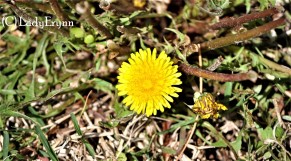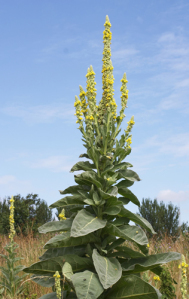With the arrival of spring rains, backyards across the midwest are blooming like crazy! Weeds of all sorts are popping up, and it’s a time for those interested in Herbalism to begin their training with the four common “beginner” weeds: Clover, Dandelion, Purple Dead Nettle, and Mullein.

Clover is part of the Trifolium genus (the Pea family) and has the same semi-sweet taste that young peas often have. Native Americans used clover as a source of food and medicine because it’s rich in protein, vitamin C, calcium, magnesium, chromium, phosphorus, potassium, niacin, and thiamine, which means that Clover can help with ailments like
- Colds
- Coughs
- Fevers
- Whooping cough and asthma
- Relaxing the nerves
- Boosting immunity
- Gout and Arthritis
- Leucorrhea
Clover is also a “pasture grass,” and planting it in fields and lawns can provide nutrients to cows, horses, chickens, deer, and other grazing animals.

Dandelions are one of the most common weeds in the northern hemisphere. They are part of the Taraxacum genus and have been used medicinally since the tenth and eleventh centuries. They are a vibrant source of vitamin K, Potassium, and vitamin A, while also containing generous amounts of calories, sodium, carbohydrates, fiber, vitamin C, vitamin B6, calcium, iron, and magnesium.
This combination allows Dandelions to help with:
- Water weight
- Liver health
- Healthy skin
- Blood sugar and cholesterol
- Boosting immunity
- Water retention
- Kidney and gall bladder health
- Detoxing
- Purifying the blood
- Bone health
Dandelions can also be a coffee substitute! Roasting and grinding the roots offer a healthier alternative to a morning cup of coffee.

Purple Dead Nettle is the big, fuzzy weed with purple flowers. It is part of the Mint family (as characterized by the square stem) and is an early source of food for hungry pollinators. It contains vitamin C, iron, fiber, and other minerals and flavonoids, which helps with:
- Chills
- Promoting Perspiration
- Menstrual Cramps
- Hemorrhages
- Infections
- Immunity
- Constipation
The leaves of Purple Dead Nettle can also be crushed and applied to cuts and bruises to prevent infections and promote healing.

Mullein is a hardy weed that belongs to the Verbascum genus. It’s characterized by it’s large, fuzzy leaves and bright yellow flowers, and is often found in fields and along roadsides. It contains a combination of flavonoids, saponins, tannins, terpenoids, glycosides, carbohydrates, proteins, fats, oils, and mucilage, which give it an advantage over such ailments as:
- Respiratory issues
- Digestion problems
- Ear Infections
- Cardiovascular Health
- Joint pain
- Dandruff
- The Lymphatic system
- Bruises and burns
In a survival situation, the crushed seeds of a Mullein plant contain a neurotoxin that momentarily stuns fish and makes them easier to catch. However, this method of fishing is illegal in standard situations.
Using these herbs is simple: you can make a tea from their flowers and leaves, add them to salads and other food items, or cook them like you would spinach. They’re a great way to add nutrients to any dish, but there are some things to keep in mind before you harvest.
First, talk to a medical professional. Some people are allergic to clover without realizing it, and any new plant/herb introduced runs the same risk.
Secondly, know your source. Public places get sprayed with pesticides and other chemicals, so whatever herbs come from there may do more harm than good. A Heath-Food store is one of the best (and safest) sources for finding herbs.
And finally, have fun with it! Herbalism is gaining attention because of its exploration into natural medicine, and springtime is the best time for harvesting and collecting herbs to use for the rest of the year. Just be sure to gather them up before the scorching winds of summer!
( Photo Credit for the Mullein goes to Clearly Organic Herbs)


One thought on “Common “Weeds” for Budding Herbalists.”